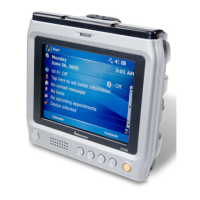Chapter 3 — Theory of Operation
60 CV30 Fixed Mount Computer Service Manual
• Blue LED (Ready-to-Work indicator). The blue light indicates when
the CV30 is ready to use in your application, typically TE 2000. The
Ready-to-Work indicator has three states:
• Off: The TE 2000 application has not loaded successfully, or you are
not running a Ready-to-Work application.
• Blinking: The CV30 is not connected to the host.
• On: A connection to the server has been established and all network
connections are active.
The LED blinks once for every cold boot it performs.
• Amber LED (Battery). The amber light comes on when the backup
battery is critically low. You need to replace the backup battery as soon
as possible.
I2C Communication
The PIC controller has a slave I2C communication port that it uses to talk
with the main processor to accept commands and report results back to the
main processor.
ON/OFF Detection
The I/O or ON/OFF key is routed into the PIC controller debouncing and
either waking the system up or putting it into suspend/sleep. PIC can issue
the PIC_IRQ to suspend or wake up the main processor.
USB Host Detect
The system must be able to detect when a USB host device, such as a PC, is
connected for ActiveSync communication. The 5 V provided in the USB
cable from the HOST is detected as an interrupt and allows the PIC
controller to wake the system up and begin communications. The signal
that is being used for this purpose is USBC_5V_DET.
Sleep and Deep Sleep Mode Detect
The PIC controller also monitors the system signal PWR_EN, which
comes out of the main processor and controls power to the processor core.
In Sleep mode this power is turned off. By monitoring this signal, the PIC
knows the status of the system and can respond accordingly. During wake
up from deep sleep, nBATT_FAULT DET will ask the PIC to issue a
PIC_IRQ to wake up the processor.
Headset Connect Detect
The PIC controller has the input nHEADSET_DET that is used to
determine when an external headset is plugged into the CV30. This input
notifies the software controlling the CODEC to route the audio signal
accordingly and potentially mute other audio paths based on user
preferences.

